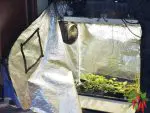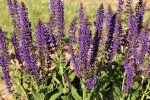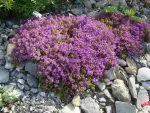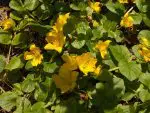This post contains affiliate links. If you buy something from one of our links we may earn a commission. Thanks
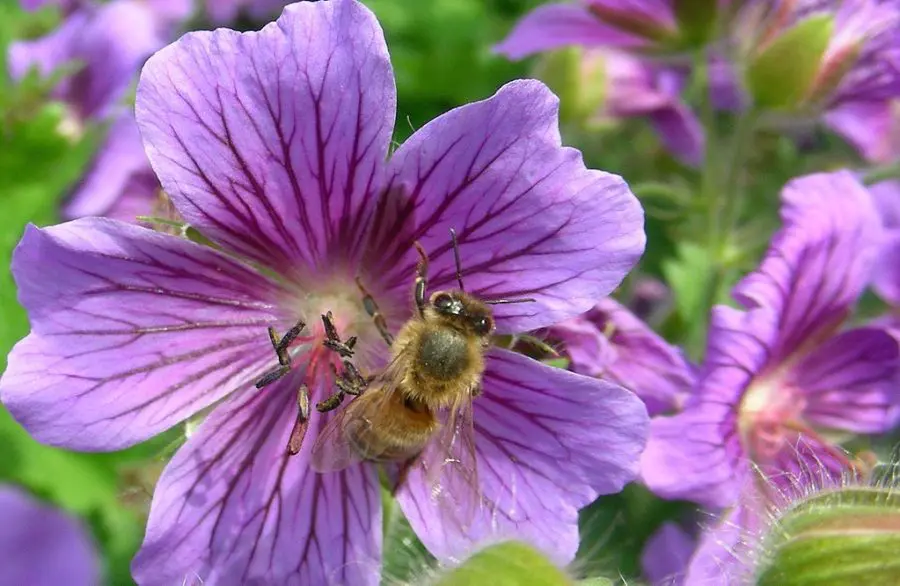
Looking for tips on geranium care in pots? Learn how to keep your geraniums healthy and thriving with our comprehensive guide to growing geraniums in containers.
Caring for Geraniums in pots requires well-draining soil and a location with at least 6-8 hours of sunlight daily. Water the plant when the soil feels dry to the touch, avoiding waterlogged conditions. During the growing season, apply a balanced fertilizer every 4-6 weeks. Deadhead spent blooms to encourage new growth.
Welcome to the wonderful world of geranium care in pots!
Whether you’re a seasoned plant enthusiast or a novice gardener, geraniums are a fantastic choice for anyone looking to add some colorful blooms to their indoor or outdoor space.
Geraniums are low-maintenance plants that are easy to care for, and with a little attention to detail, they can thrive in pots all year round.
In this post, we’ll take you through the ins and outs of geranium care in pots, so you can enjoy these beautiful flowers to their fullest potential. So grab your gardening gloves and let’s get started!
An Introduction To Geranium Care In Pots
Geraniums are a favorite among many gardeners due to their vibrant flowers, ease of care, and versatility.
Whether you’re a seasoned gardener or just starting, growing geraniums in pots is an excellent way to add color and life to your indoor or outdoor spaces.
In this guide, we’ll cover everything you need to know about geranium care in pots, from choosing the right potting mix and containers to watering and fertilizing your plants.
So, whether you’re looking to brighten up your windowsills, balconies, or patios, read on to learn all about caring for these beautiful plants in pots!
Overview of geraniums
Geraniums, also known as Pelargoniums, are a popular type of flowering plant that comes in a variety of shapes, sizes, and colors.
They are relatively easy to care for and can be grown both indoors and outdoors.
Geraniums are native to South Africa and are generally considered a low-maintenance plant.
They are ideal for beginners who are just starting to explore the world of gardening.
Geraniums are a diverse group of plants, with many different varieties available for gardeners to choose from.
Here are some of the most common types of geraniums:
Zonal Geraniums: These are the most popular type of geranium, known for their large, showy flowers and brightly colored foliage. They get their name from the distinctive “zone” of color that appears on the leaves.
Ivy Geraniums: These geraniums have long, trailing stems and ivy-shaped leaves, making them a popular choice for hanging baskets and window boxes. They bloom profusely with clusters of small, delicate flowers.
True Geraniums: Also known as cranesbill geraniums, these plants are not actually related to the common garden geranium. They are hardy, low-growing perennials that produce small, delicate flowers.
Pelargonium x hortorum: These are the most commonly grown garden geraniums, and are often simply referred to as “common geraniums.” They have large, colorful flowers and come in a variety of colors.
Hardy Geraniums: These are a type of true geranium, and are valued for their hardiness and ability to grow in a wide range of conditions. They are often used as ground cover or border plants.
Perennial Geraniums: These are another type of true geranium, and are valued for their long blooming period and ability to thrive in a variety of growing conditions.
Regal Geraniums: These are a type of pelargonium, and are known for their large, showy flowers and ornamental foliage. They are often grown as indoor plants.
Annual Geraniums: These are a type of pelargonium, and are often grown as bedding plants or in containers. They have a long blooming period and come in a variety of colors.
Overwinter Geraniums: This is a technique used to keep pelargoniums alive through the winter months. The plants are dug up, trimmed back, and stored in a cool, dry place until the following spring.
Martha Washington Geraniums: These are a type of regal geranium, and are valued for their large, showy flowers and ornamental foliage.
Pelargonium species: There are many different species of pelargonium, each with its own unique characteristics and growing requirements.
Genus Pelargonium: This is the genus that includes all types of pelargoniums, including garden geraniums and ivy geraniums.
Benefits of growing geraniums in pots
Growing geraniums in pots offer a number of benefits. Firstly, it allows you to control the environment in which the plant is grown.
This means that you can ensure that the plant is receiving the right amount of light, water, and nutrients.
Additionally, growing geraniums in pots makes it easier to move them around, which is particularly useful if you want to keep them out of direct sunlight during the hottest part of the day.
Potting geraniums also allows you to enjoy the benefits of gardening even if you have limited space, such as a small balcony or patio.
Indoor Benefits of Geraniums
Geraniums are a popular choice among plant enthusiasts and for a good reason.
These colorful and fragrant blooms are easy to care for and can brighten up any indoor space with their vibrant shades of pink, purple, and red.
But did you know that geraniums are not just pretty faces? They also offer a range of benefits when grown indoors, making them the perfect addition to any living space.
In this section, we’ll take a closer look at the indoor benefits of geraniums, so you can make the most of these beautiful plants in your home.
Air purification:
Not only do geraniums look beautiful, but they also act as natural air purifiers, removing harmful toxins from the air in your home.
This is especially beneficial for those who suffer from allergies or asthma.
Geraniums are known to absorb pollutants like benzene, formaldehyde, and trichloroethylene, which are commonly found in indoor air.
These plants can help to create a healthier environment for you and your family.
Natural mood booster:
Geraniums are not only good for your physical health, but they can also have a positive impact on your mental health.
Studies have shown that indoor plants, including geraniums, can help to reduce stress and anxiety levels, boost mood, and improve concentration.
Having a geranium plant in your home can be a great way to create a more relaxed and calming environment.
Aesthetically pleasing:
In addition to their health benefits, geraniums are also aesthetically pleasing and can add a touch of color and beauty to your indoor space.
With their wide variety of colors and shapes, geraniums can fit into any design scheme and add a pop of color to any room.
They are also versatile enough to be grown in different types of pots and containers, making them a great option for any space.
Plant Size and Pot Requirements
When it comes to growing geraniums in pots, the right pot size and soil mix can make all the difference.
Geraniums are relatively compact plants, but they still need adequate space to grow healthy and strong.
Choosing the right pot size and type is crucial for your plant’s overall health and vitality.
In this section, we’ll explore the best pot sizes and soil mixes for different types of geraniums to ensure they thrive in their pot homes.
Plant size considerations
When it comes to planting geraniums in pots, it’s important to consider the size of the plant.
Geraniums can grow up to 3 feet tall and 2 feet wide in the right conditions.
While they won’t grow as large in a pot as they would in the ground, they still need enough space to spread out their roots and grow properly.
So, make sure you choose large pots that are at least 8-10 inches deep and wide enough to accommodate the plant’s mature size.
Pot size considerations
The size of the pot is important for the plant’s growth, as well as its overall health.
A pot that is too small can restrict root growth, leading to poor plant growth and possibly root rot.
On the other hand, a pot that is too large can hold too much water, causing the soil to become waterlogged and leading to root rot.
So, it’s important to choose the right pot size for your geraniums. When transplanting, you can choose a pot that is slightly larger than the previous one, allowing room for the plant to grow.
Types of pots for geraniums
When it comes to choosing a pot for your geraniums, there are many options available.
Some popular choices include clay pots, plastic pots, and glazed ceramic pots. Clay pots are a good choice for geraniums because they are porous and allow for good air circulation.
Plastic pots are lightweight and easy to move around, making them a good choice if you need to move your plants frequently.
Glazed ceramic pots are a stylish choice, but make sure they have drainage holes and don’t retain too much water.
Ultimately, the type of pot you choose will depend on your personal preference and the growing conditions in your home.
Lighting Requirements
When it comes to growing geraniums in pots, lighting is a critical factor that determines the success of your plants.
Geraniums need plenty of light to thrive, but the type of light they receive also plays a significant role.
In this section, we’ll discuss the different lighting requirements for geraniums in pots and how to provide your plants with the ideal light conditions for healthy growth.
So, whether you’re a seasoned gardener or just starting, read on to learn more about how to light up your geraniums!
Hours of sun per day
Geraniums require several hours of sunlight every day to thrive. Ideally, they need around 6 to 8 hours of direct sunlight each day.
If your geraniums are indoors, try placing them in a sunny window that gets plenty of natural light, such as near a window facing south or west.
Light levels needed
When it comes to light levels, geraniums prefer bright light but not direct full sun all day long.
They can also tolerate some shade, especially during the hottest part of the day.
If you notice that your geraniums are getting leggy or not blooming, it may be a sign that they’re not getting enough light.
Artificial lighting options
If your geranium plants aren’t getting enough natural light, you can supplement them with artificial lighting.
LED grow lights are a great option for indoor geraniums, as they emit the right spectrum of light that plants need to grow.
You can also use fluorescent lights, but they tend to be less energy-efficient and generate more heat.
When using artificial lighting, make sure to keep the lights on for at least 12 to 16 hours a day.
Watering Needs
When it comes to caring for geraniums in pots, one of the most critical factors to consider is watering.
As with any plant, it’s important to make sure your geraniums are receiving enough water to thrive without overwatering them.
Geraniums are drought-tolerant, which means they can survive in periods of dry soil, but it’s essential to make sure they receive adequate hydration to produce healthy foliage and blooms.
In this section, we’ll discuss the watering needs of geraniums in pots, how often they should be watered, and what to look for when determining if your plant needs watering.
How much water to give:
The amount of water geraniums require in pots is dependent on factors such as the size of the pot, the plant size, and the temperature and humidity levels in the environment.
As a general rule, geraniums require consistent moisture, but not soggy soil.
How often to water:
It’s important to water geraniums in pots regularly to keep the soil consistently moist but not waterlogged.
Generally, geraniums need to be watered every 5-7 days. However, you should adjust watering schedules based on the pot size, plant size, temperature, and humidity levels.
Signs of overwatering and underwatering:
Signs of overwatering include yellowing leaves, a mushy stem, and soil that is constantly wet.
Underwatering can cause leaves to wilt, and the soil will be dry. It’s important to find the right balance between keeping the soil moist and not overwatering.
Best watering practices:
The best watering practices for geraniums in pots include using pots with good drainage holes, watering the soil rather than the foliage, and avoiding letting the soil dry out completely.
You can also use a moisture meter to monitor the soil moisture levels and prevent over or underwatering or sticking a finger in the top inch of soil. If the soil is still moist wait a day or two before watering.
Soil and Potting Mix – using coco coir and perlite
Caring for geraniums in pots is not just about watering and lighting. One of the most important aspects is choosing the right potting mix.
Using the correct mix of soil and potting medium can ensure your geraniums thrive and flourish.
One popular choice is a mixture of coco coir and perlite, which provides excellent drainage and air circulation for the roots.
In this section, we will discuss the benefits of coco coir and perlite as a potting mix for geraniums, as well as how to use them effectively.
Importance of well-draining soil:
Having well-drained soil is essential for the health of your potted geraniums.
Soil that retains too much water can lead to root rot, which can be detrimental to the plant’s overall health.
Good drainage also helps to ensure that the plant gets enough oxygen to its roots.
When the soil is too wet, it can become anaerobic, and this can lead to the death of the roots.
This is why it is important to use soil that has good drainage properties.
Best soil mix for geraniums-coco coir and perlite:
Coco coir and perlite make an excellent soil mix for growing geraniums in pots.
Coco coir is an organic material made from the fibrous husks of coconuts. It has excellent water-holding capacity and is pH neutral, making it an ideal component for potting mixes.
Perlite, on the other hand, is a volcanic rock that has been heated and expanded. It has excellent drainage properties, making it an ideal addition to potting mixes.
The combination of coco coir and perlite creates a well-draining soil mix that allows for proper aeration and water retention, creating an optimal growing environment for geraniums in pots.
Use of coco coir in potting mix:
Coco coir is a sustainable alternative to peat moss, which is commonly used in potting mixes.
Peat moss is a non-renewable resource that is mined from bogs, making it an unsustainable choice for gardening.
Coco coir, on the other hand, is a renewable resource that is made from the waste product of coconut production.
It has excellent water retention properties, allowing it to hold onto moisture for longer periods.
It also helps to improve soil structure and aeration, which is important for the overall health of the plant.
By using coco coir in your potting mix, you are not only creating an optimal growing environment for your geraniums but also making a more sustainable choice for the planet.
Fertilizing Requirements
Fertilizing is an essential aspect of geranium care in pots. Providing your geraniums with proper nutrition can enhance their growth and keep them healthy.
But with so many fertilizers available in the market, it can be challenging to choose the right one.
In this section, we’ll cover the basics of fertilizing geraniums in pots to help you keep your plants thriving.
Frequency of Fertilization
When it comes to fertilizing your geraniums, it is important to find a balance between not fertilizing enough and over-fertilizing.
Typically, geraniums need to be fertilized every 4-6 weeks during their growing season, which is from early spring to late summer.
During the winter months, you can reduce the frequency to once every 8-12 weeks.
Types of Fertilizers to Use
There are many types of fertilizers available on the market that you can use for your geraniums.
However, it is best to use a balanced fertilizer with equal parts nitrogen, phosphorus, and potassium (NPK).
This will ensure that your geraniums receive all the essential nutrients they need to thrive.
Slow-Release Fertilizer Options
If you want to simplify your fertilization routine, you can also consider using slow-release fertilizers.
These fertilizers release nutrients over a longer period of time, which means you only need to apply them once every 2-3 months.
Slow-release fertilizers can be found in pellet or granule form, and they are available in both synthetic and organic options.
Temperature and Humidity
When it comes to geraniums, temperature and humidity play an important role in their growth and overall health.
These popular plants thrive in moderate temperatures, and maintaining the right levels of humidity can make a significant difference.
In this section, we’ll take a closer look at the ideal temperature and humidity ranges for geraniums grown in pots, and how to maintain those conditions for your plants.
So let’s dive in and learn more about the temperature and humidity needs of these beautiful and versatile plants.
Optimal temperature range
Geraniums are tough plants and can tolerate a wide range of temperatures, but they thrive in temperatures between 60°F to 75°F (15.5°C to 23.8°C).
The temperature should not drop below 45°F (7.2°C) or rise above 85°F (29.4°C).
It is essential to avoid exposing geraniums to temperature extremes, which can stress them and lead to stunted growth or even death.
Importance of humidity
Geraniums prefer moderate humidity levels ranging from 40% to 60%.
Low humidity levels can cause the leaves to turn yellow and brown, while high humidity can lead to fungal diseases such as powdery mildew.
Maintaining a balanced humidity level is crucial for healthy geranium growth.
How to regulate temperature and humidity in indoor settings
If you’re growing geraniums indoors, it’s important to monitor the temperature and humidity levels.
You can use a hygrometer to measure the humidity level and a thermometer to monitor the temperature.
To regulate temperature, keep geraniums away from drafty areas and direct sunlight.
You can also use a space heater or air conditioner to regulate the temperature.
To regulate humidity, you can use a humidifier or a tray filled with pebbles and water placed underneath the pot.
Maintenance and Pruning
Maintaining your geraniums is crucial for their health and longevity.
Regular pruning can encourage new growth and ensure your plants stay looking their best.
Proper care can help prevent pests and diseases and promote overall plant health.
In this section, we will discuss some tips and techniques for keeping your geraniums healthy and thriving.
• Deadheading spent flowers is an important part of maintaining the health and beauty of your geraniums in pots. By removing the spent blooms, you encourage the plant to produce more flowers and prevent the formation of seed heads
• Trimming back overgrown branches can help promote bushier growth and prevent the plant from becoming too leggy. You can use pruning shears or sharp scissors to remove any branches that are growing too long or out of shape.
• Removing yellow or diseased leaves is important for the overall health of the plant. These leaves can be a sign of a fungal disease or overwatering. By removing them promptly, you prevent the spread of disease and help the plant focus its energy on healthy growth.
Repotting
Repotting your geraniums is an essential part of their care, especially as they continue to grow and mature.
In this section, we will cover when and how to repot your geraniums to ensure they continue to thrive in their new larger containers.
Repotting not only provides more space for the roots to grow but also refreshes the soil, making sure your plant is getting the nutrients it needs.
With a little bit of care and attention, your geraniums will flourish in their new pot.
Signs that a geranium needs repotting
As your geranium grows, it may become root-bound, which means it has outgrown its current pot and requires more space to grow.
When you notice that the roots are tightly packed and visible through the drainage holes, it’s a sign that your geranium needs to be repotted.
Best time to repot
The best time to repot your geranium is in the early spring before the growing season begins. T
his gives the plant plenty of time to adjust to its new environment before it starts to bloom.
How to repot a geranium step-by-step list
• Choose a pot that is one size larger than the current one. Make sure it has drainage holes at the bottom.
• Fill the bottom of the new pot with a layer of fresh potting mix.
• Gently remove the geranium from its current pot, being careful not to damage the roots.
• Place the plant in the new pot and add fresh potting mix around it, pressing it down gently.
• Water the plant thoroughly and place it in a bright location with indirect sunlight.
• Monitor the plant carefully for the next few days, keeping the soil moist but not overly wet.
Propagation
If you’re looking to expand your geranium collection or simply want to share your love of geraniums with friends and family, propagation is a fun and rewarding option.
Luckily, geraniums are relatively easy to propagate, making it a great project for both beginners and experienced gardeners alike.
In this section, we’ll cover the various methods of propagation, from stem cuttings to seed germination, so you can find the best fit for your needs.
Taking Stem Cuttings
To propagate geraniums from stem cuttings, you’ll first need to choose healthy mother plants.
Look for plants with new growth and healthy leaves. Then, using clean, sharp scissors, take a 3-4 inch cutting from the stem of the plant just below a node, where the leaf attaches to the stem.
Make sure the cutting has at least three nodes and remove any leaves from the bottom inch of the stem.
Rooting Stem Cuttings
Next, you’ll need to root the stem cutting. Dip the bottom of the stem into rooting hormone, if desired, and insert it into a pot filled with a well-draining soil mix.
You can use the same coco coir and perlite mix recommended for potting your geraniums.
Water the soil well and cover the pot with a plastic bag to create a humid environment.
Place the pot in a bright, warm location, but not in direct sunlight.
Planting New Cuttings in Pots
After a few weeks, you should see new roots forming on the stem cutting.
At this point, you can remove the plastic bag and move the pot to a sunny location.
Water the cutting regularly, but be careful not to overwater. Once the cutting has grown to be about 3-4 inches tall, you can transplant it into a larger pot or into your garden.
Division
Another way to propagate geraniums is by division. If your geranium has become too large for its pot, you can divide it into smaller sections and repot them.
To do this, carefully remove the plant from its pot and separate the root system into smaller sections.
Make sure each section has at least one healthy stem and several roots.
Then, plant each section into a new pot filled with a well-draining soil mix and water thoroughly.
Remember, it’s important to keep your new plants in a bright location and water them regularly, but not too much.
With a little patience and care, you’ll soon have a beautiful collection of geraniums to enjoy!
Common Pests and Diseases
If you’re growing geraniums in pots, it’s important to be aware of the pests and diseases that can harm your plants.
Dealing with infestations and infections can be frustrating, but with a little knowledge and a proactive approach, you can keep your geraniums healthy and thriving.
In this section, we’ll take a look at some of the most common pests and diseases that affect geraniums, as well as how to prevent and treat them.
Spider mites:
These tiny pests are one of the most common problems that geraniums face, and they can cause a lot of damage if not dealt with promptly.
They are often found on the undersides of leaves and can be identified by the small webs they spin.
To get rid of spider mites, wash the plant with a strong jet of water or apply a solution of neem oil and water.
Aphids:
Another common pest that can attack geraniums is aphids. These small insects are often found on new growth and can cause leaves to curl and yellow.
To control aphids, you can wash the plant with a strong jet of water or apply insecticidal soap.
Fungal diseases:
Geraniums can be susceptible to fungal diseases, especially if they are grown in humid conditions or if the soil is consistently moist.
Common fungal diseases include powdery mildew and botrytis. To prevent these diseases, ensure that the plant has good air circulation and avoid overhead watering.
Root rot:
Root rot is a serious problem for geraniums and can be caused by overwatering or poorly draining soil.
Signs of root rot include yellowing leaves and a soft, mushy stem, or foul smelling soil.
To prevent root rot, ensure that the soil is well-draining and avoid overwatering the plant.
If root rot has already set in, it may be necessary to repot the plant with fresh, well-draining soil to save it.
Geranium FAQs
If you’ve chosen to adorn your home or patio with potted geraniums, you’re in for a treat.
These plants are generally low-maintenance but come with their own set of needs that, when addressed, result in beautiful blooms and lush foliage.
From sun exposure to watering routines, many factors affect the health of your geraniums.
Below are some frequently asked questions to help you care for your potted geraniums in the best way possible.
Q. How do you keep potted geraniums blooming?
A. To keep your potted geraniums blooming, make sure they receive at least 6-8 hours of sunlight each day.
You can also encourage blooming by applying a balanced, water-soluble fertilizer every 4-6 weeks during the growing season.
Q. Do you need to deadhead geraniums?
A. Yes, it’s advisable to deadhead geraniums to encourage new blooms.
Simply remove the faded flowers at the stem to make way for new growth.
Q. How do you keep potted geraniums healthy?
A. To keep potted geraniums healthy, plant them in well-draining soil, and provide adequate sunlight, and water only when the soil feels dry to the touch.
Also, apply a balanced fertilizer every 4-6 weeks during the growing season.
Q. Do geraniums like sun or shade?
A. Geraniums prefer a sunny location and need at least 6-8 hours of sunlight each day.
However, they can tolerate partial shade, especially in hot climates where afternoon shade can be beneficial.
Q. How often should you water geraniums?
A. Watering frequency for geraniums depends on climate and soil conditions. Generally, water when the top inch of soil feels dry to the touch.
Over-watering can lead to root rot, so it’s crucial to allow the soil to dry out between waterings.
Conclusion
Congratulations on making it this far! By now, you should have a good understanding of how to care for your geraniums in pots.
Remember, geraniums are hardy plants that require a little bit of love and care to thrive.
From the right pot size and soil mix to proper watering, fertilizing, and pruning techniques, taking care of geraniums in pots is a rewarding and fulfilling experience.
By following the tips and guidelines outlined in this guide, you’ll be well on your way to growing beautiful and healthy geraniums in your own home. Happy gardening!
Recap of geranium care in pots:
In this post, we have covered all the essential information you need to know to grow healthy and vibrant geraniums in pots.
From selecting the right pot size and soil mix to lighting and watering requirements, we’ve discussed it all.
We’ve also talked about how to maintain your geraniums through pruning, repotting, and propagation.
Finally, we’ve covered some common pests and diseases that can afflict geraniums and how to prevent and treat them.
Final tips and advice for growing geraniums in pots:
Growing geraniums in pots is a great way to add a pop of color to your indoor or outdoor space.
However, it’s important to keep in mind that every plant has different needs, and your geraniums will thrive when you give them the proper care.
Remember to water your geraniums consistently, provide them with enough light, and fertilize them regularly.
Keep an eye out for pests and diseases, and act quickly if you notice any issues.
By following these tips and giving your geraniums the attention they deserve, you’ll have a beautiful and healthy plant to enjoy for years to come.
Read more: 20 Benefits Of Keeping Indoor Plants
























